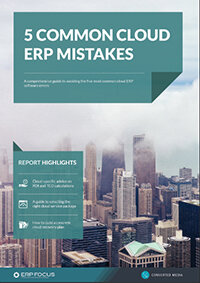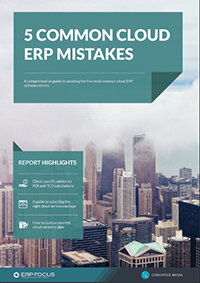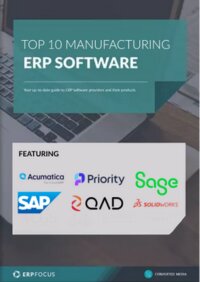How to find manufacturing success with cloud ERP
Whether we like it or not, the cloud is here to stay and manufacturers will have to get used to it. Those who have not yet migrated some their legacy ERP system to the cloud will need to think long and hard about how and when they’re going to make the transition. It’s no longer 'if.'
Current ERP implementations in the cloud can be tailored to meet a variety of short-term and long-term needs, speeding up initial implementation and achieving ROI faster. Without the unnecessary baggage of on-premise IT hardware and infrastructure to weigh you down, cloud ERP can be easily implemented across multiple regions, subsidiaries, and divisions with minimal cost and significant time savings. Cloud ERP deployments typically take only 3-6 months compared to the typical 12 months for an on-premise solution.
Infrastructure
On-premise manufacturing ERP systems tend to silo transactional data, making it difficult to share across software and operating system platforms. Cloud ERP eliminates those silos and makes it easier to share data across platforms and the entire enterprise, providing access to real-time data anywhere, any time on workstations, desktops, and mobile devices.
Use our guide to cloud ERP mistakes to get the most out of your cloud ERP and avoid fatal errors
Cloud-based solutions enable companies to rapidly establish new business units or expand existing operations virtually anywhere without having to expand or integrate IT infrastructure, substantially minimizing both capital investment and risk. They also offer better business results by making it easier to share information with partners and suppliers regardless of where they are located.
Customization
With on-premise legacy manufacturing ERP systems, change can be slower and more costly. Every customized manufacturing or business process revision or upgrade has to go through IT or perhaps an external supplier or consultant.
The cloud gives the power of custom configuration to the actual user, bypassing IT and outside providers to achieve faster results while saving time and money. Hosted SaaS ERP solutions are continually upgraded by the provider so employees are assured of working with the latest ERP application version and having previous custom modifications carried forward with it.
ERP security
With cybersecurity a real and growing concern for manufacturers, cloud ERP provides better security in addition to improved accessibility. Many cloud-based ERP solution providers prioritize securing their systems and provide strong, industry standard data security certifications such as PCI DSS and SAS 70 standards compliance.
The cloud enables workers to do their jobs better, faster, and with greater flexibility by removing the handcuffs of proprietary on-premise systems. Workers today are already used to living in the cloud, so to perform their jobs there as well is an intuitive extension requiring minimal training, unlike having to learn an arcane legacy system.
The real power of the cloud is the way it enables manufacturers to spend less time and money managing their IT and more time growing their businesses. Users can access all that operational functionality in the cloud – process design, production management, business processes, and virtualization, to name a few. The cloud supports closer, easier collaboration with suppliers and customers without proprietary IT walls between them.
Removing barriers, improving collaboration, streamlining operations, making change easier, providing the flexibility and scalability to address the challenges of a rapidly-evolving marketplace and the competition that lurks there – that’s the promise of the cloud.
Free white paper

Five common cloud ERP mistakes
Get your comprehensive guide to avoiding the five most common cloud ERP errors

Featured white papers
Related articles
-

4 training tips for manufacturing ERP success
These four training tips will help your employees get the most out of your new manufacturing ERP ...
-

Secret KPI: Why Your ERP Implementation Team Matters More Than Software
Learn how Godlan ensures successful ERP implementation for manufacturers with proven strategies &...
-

ERP for make-to-order manufacturing
How can ERP help your make-to-order manufacturing business thrive?




